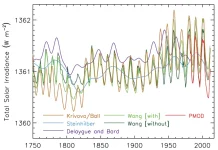- Joined
- Dec 22, 2012
- Messages
- 80,308
- Reaction score
- 27,370
- Location
- Portlandia
- Gender
- Male
- Political Leaning
- Libertarian - Right
Now that the AR6 is finalized, I took some time today to skim through it. I know there are people why deny that the IPCC is just a over-bloated agenda driven global government conception, but it continually pouts out cherry picked science to suit their agenda over the nations of the world. They rarely ever lie. They just take the facts of science, and intelligently choose what fits their agenda. I believe this is the correct link to download the AR6 from:
Here is my first example regarding the misconception.
On page 957 of the AR6:
So, this seems like a proper comparison at face value, but it isn't. Here is a graphical reason as to why this is misleading, and the authors most certainly know it is:

To properly evaluate two periods of the sun like they are doing, the entire cycle needs to be averages. Not just the 7 year low period. Look how small the high to low variations are at around 1745 to the larger variation around 2008 for the full power cycle of the sun.
This is intentional low-balling of the solar change! Even at that, they close a study that uses lower changes in TSI than is commonly recognized to get down to their 0.05 W/m^2 level. Now their 0.05 represents about a 0.28 W/m^2 change of TSI because of the rotation of the earth, sphere vs. disk, and albedo.
From my perspective, this is scientific malpractice.
Here is my first example regarding the misconception.
On page 957 of the AR6:
The AR5 (Myhre et al., 2013b) assessed solar SARF from around
1750 to 2011 to be 0.05 [0.00 to 0.10] W m–2 which was computed
from the seven-year mean around the solar minima in 1745 (being
closest to 1750) and 2008 (being the most recent solar minimum).
The inclusion of tropospheric adjustments that reduce ERF (compared
to SARF in AR5) has a negligible effect on the overall forcing.
So, this seems like a proper comparison at face value, but it isn't. Here is a graphical reason as to why this is misleading, and the authors most certainly know it is:

To properly evaluate two periods of the sun like they are doing, the entire cycle needs to be averages. Not just the 7 year low period. Look how small the high to low variations are at around 1745 to the larger variation around 2008 for the full power cycle of the sun.
This is intentional low-balling of the solar change! Even at that, they close a study that uses lower changes in TSI than is commonly recognized to get down to their 0.05 W/m^2 level. Now their 0.05 represents about a 0.28 W/m^2 change of TSI because of the rotation of the earth, sphere vs. disk, and albedo.
From my perspective, this is scientific malpractice.

